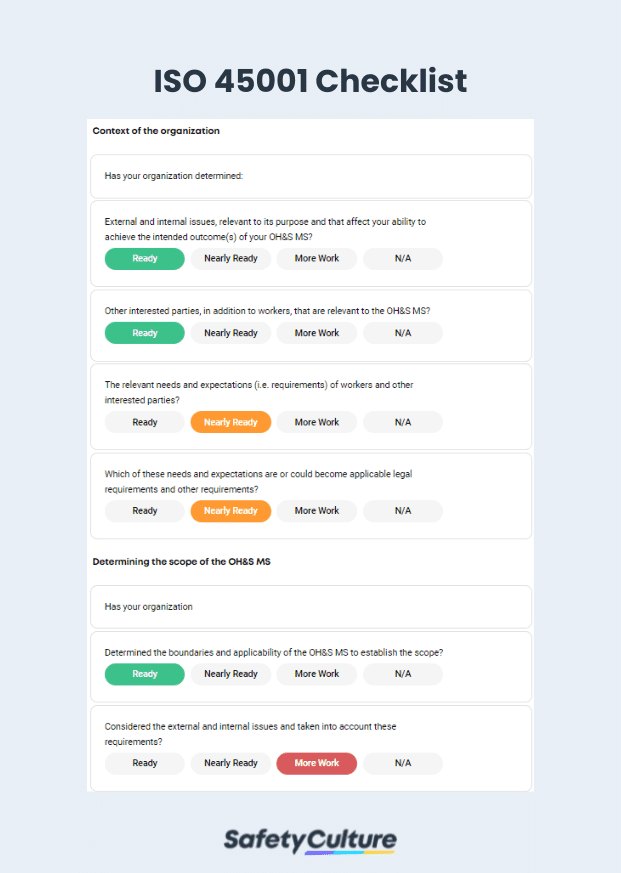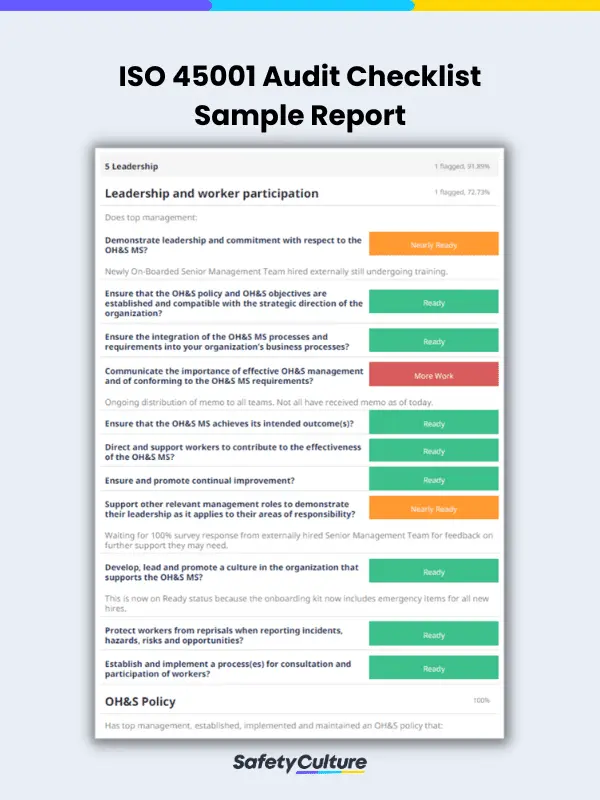What is an ISO 45001 Audit Checklist?
An ISO 45001 audit checklist template is a tool used as a guide for organization when assessing their OH&S management system. It helps in assessing how aligned it is with the ISO 45001 standard by conducting internal audits. It can also be used by companies when preparing for ISO certifications by covering relevant ISO 45001 audit questions based on its key clauses.
ISO 45001 Checklist Requirements
An effective ISO 45001 audit checklist is structured around the 7 clauses of the standard. It’s main elements or requirements comprises of the following:
- Context of the Organization
- Issues: Identify factors affecting OH&S performance.
- Stakeholders: Determine interested parties and their OH&S needs.
- Leadership and Worker Participation
- Commitment: Ensure management demonstrates commitment to OH&S.
- Policy: Verify a communicated safety policy is in place.
- Participation: Establish processes for worker involvement in safety.
- Planning
- Risks: Identify safety risks and improvement opportunities.
- Hazards: Implement hazard recognition processes.
- Legal Requirements: Ensure access to current legal obligations.
- Objectives: Set measurable OH&S performance goals.
- Support
- Resources: Confirm availability of necessary resources.
- Training: Ensure personnel are trained and aware of responsibilities.
- Communication: Establish internal and external OH&S communication processes.
- Operation
- Control Procedures: Maintain procedures to meet OH&S requirements.
- Change Management: Control changes impacting safety performance.
- Emergency Preparedness: Document emergency procedures and conduct drills.
- Performance Evaluation
- Monitoring: Track performance against objectives and compliance.
- Audits: Conduct regular internal audits of the OH&S system.
- Reviews: Review the system regularly for ongoing suitability.
- Improvement
- Incident Management: Create processes for reporting and investigating incidents.
- Corrective Actions: Address non-conformities from audits or incidents.
- Continuous Improvement: Promote ongoing enhancement of OH&S practices.
How to Prepare for Certification
Below are key steps involved in the preparation for ISO 45001 certification:
- Understand the ISO 45001 Standard
- Identify gaps in the existing OH&S Management System by conducting a gap analysis or readiness test to meet ISO 45001:2018 requirements using an ISO 45001 audit checklist.
- Develop an implementation plan using the Plan-Do-Check-Act (PDCA) cycle.
- Define your organization’s competency and training requirements and provide required training for employees.
- Document OH&S policies and procedures
- Put the documented policies and procedures into practice across the organization
- Conduct internal audits to identify areas for improvement and assess effectiveness of implemented OH&S management system.
- Select a certification body to do the external audit for ISO 45001 certification.
How to Conduct an ISO 45001 Internal Audit
For an effective internal audit for ISO 45001, a systematic approach should be taken, this consists of the following:
- Assign internal auditors: Choose trained auditors who are not directly involved in the areas being audited to maintain objectivity.
- Develop an audit program: Develop a program that defines the frequency, scope, and objectives of audits, aligned with the organization’s risks and opportunities.
- Prepare and audit plan: Create a detailed plan that includes the objectives and criteria for the audit, the methods and resources required, a schedule of activities, and a list of documents to be reviewed.
- Use a checklist: Use an ISO 450001 audit checklist that includes all relevant clauses of the ISO 45001 standard to guarantee a thorough evaluation.
- Conduct the audit: Systematically follow the audit plan, gathering evidence to verify compliance with ISO 45001 requirements, and record findings, highlighting both conformities and non-conformities.
- Report findings: Create a report that outlines the audit results, including the evidence collected and any issues found. Categorize the findings as either conformities or non-conformities, and designate responsibilities for corrective actions.
- Implement corrective actions: Promptly address any identified non-conformities, documenting the actions taken to resolve them. Set deadlines for corrective actions and follow up to ensure their effectiveness.
- Review and improve: Leverage the findings from the internal audit to pinpoint areas for improvement in the OHSMS. Promote a culture of continuous improvement by regularly reviewing processes and making necessary changes.
Why Use a Checklist for Conducting ISO 45001 Audits
Using a checklist for conducting ISO 45001 audits can be extremely beneficial for a number of reasons, including the following:
- Ensures comprehensive coverage – This checklist covers all the key ISO 45001 requirements of the standard, which ensures that no important aspect is missed during the audit, making it comprehensive and accurate.
- Increases efficiency – A pre-defined list of questions and requirements can help the auditor to move through the audit process logically, more quickly, and with greater ease. This can help to save time and resources, allowing the auditor to focus on areas of greater concern or interest.
- Improves communication – A checklist also helps keep all stakeholders involved in the audit process. By having a clear understanding of what is being audited and how the process works, communication between the auditor and the organization can be improved, leading to more effective collaboration.
ISO 45001 Audit Report Sample
Now that you know the most important components of an effective ISO 45001 audit checklist and how to create one for your organization, you must also know what it looks like as a completed report. Below is an example of a filled-out ISO 45001:2018 audit checklist.



